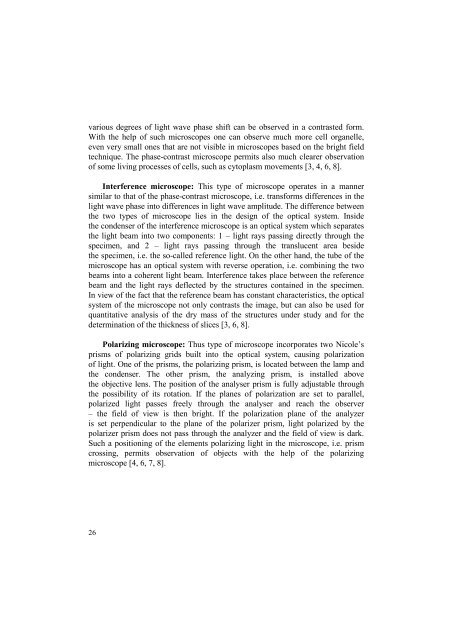MICRO-STRUCTURE ANALYSIS OF PLANT TISSUES - Lublin
MICRO-STRUCTURE ANALYSIS OF PLANT TISSUES - Lublin
MICRO-STRUCTURE ANALYSIS OF PLANT TISSUES - Lublin
You also want an ePaper? Increase the reach of your titles
YUMPU automatically turns print PDFs into web optimized ePapers that Google loves.
various degrees of light wave phase shift can be observed in a contrasted form.<br />
With the help of such microscopes one can observe much more cell organelle,<br />
even very small ones that are not visible in microscopes based on the bright field<br />
technique. The phase-contrast microscope permits also much clearer observation<br />
of some living processes of cells, such as cytoplasm movements [3, 4, 6, 8].<br />
Interference microscope: This type of microscope operates in a manner<br />
similar to that of the phase-contrast microscope, i.e. transforms differences in the<br />
light wave phase into differences in light wave amplitude. The difference between<br />
the two types of microscope lies in the design of the optical system. Inside<br />
the condenser of the interference microscope is an optical system which separates<br />
the light beam into two components: 1 – light rays passing directly through the<br />
specimen, and 2 – light rays passing through the translucent area beside<br />
the specimen, i.e. the so-called reference light. On the other hand, the tube of the<br />
microscope has an optical system with reverse operation, i.e. combining the two<br />
beams into a coherent light beam. Interference takes place between the reference<br />
beam and the light rays deflected by the structures contained in the specimen.<br />
In view of the fact that the reference beam has constant characteristics, the optical<br />
system of the microscope not only contrasts the image, but can also be used for<br />
quantitative analysis of the dry mass of the structures under study and for the<br />
determination of the thickness of slices [3, 6, 8].<br />
Polarizing microscope: Thus type of microscope incorporates two Nicole’s<br />
prisms of polarizing grids built into the optical system, causing polarization<br />
of light. One of the prisms, the polarizing prism, is located between the lamp and<br />
the condenser. The other prism, the analyzing prism, is installed above<br />
the objective lens. The position of the analyser prism is fully adjustable through<br />
the possibility of its rotation. If the planes of polarization are set to parallel,<br />
polarized light passes freely through the analyser and reach the observer<br />
– the field of view is then bright. If the polarization plane of the analyzer<br />
is set perpendicular to the plane of the polarizer prism, light polarized by the<br />
polarizer prism does not pass through the analyzer and the field of view is dark.<br />
Such a positioning of the elements polarizing light in the microscope, i.e. prism<br />
crossing, permits observation of objects with the help of the polarizing<br />
microscope [4, 6, 7, 8].<br />
26

















